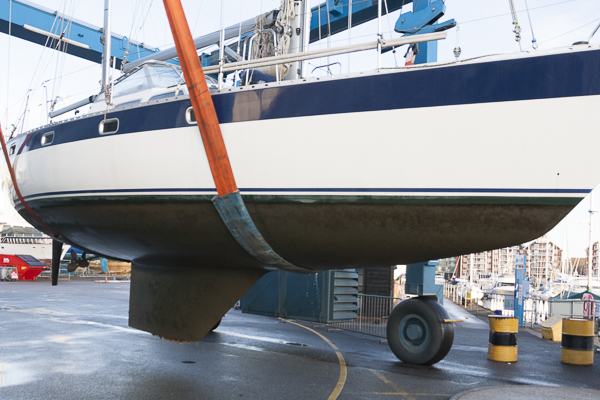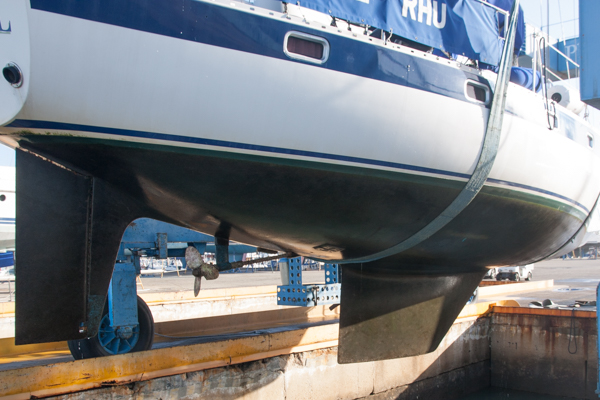Applying anti-fouling is an unpleasant annual chore that gets worse the bigger the boat, so during the 2009/10 re-fit we had Coppercoat anti-fouling professionally applied to Speedwell. This product consists of copper powder in an epoxy resin that’s applied to the boat in a number of coats. In our case this was on top of new gellcoat and an epoxy barrier layer following treatment for osmosis so we had it applied to a brand new hull surface.
The manufacturer claims that Coppercoat should be effective for over 10 years and various independent tests appear to back this up. This should mean that the relatively high cost of application is recovered against the cost and time saved by not having to apply traditional anti-fouling over the years.
Speedwell looked very smart in her new anti-foul:
 |
 |
 |
First Year
After our first season with the new coating we were interested to see what she looked like when she was hauled out. The answer was very good. There was a thin coating of slime on the hull that quickly came off with a pressure wash, apart from that the hull was clean as a whistle. The only fouling was a few barnacles on the prop shaft, which isn’t coated (it’s just plain stainless steel). This season Speedwell had spent several months on the English east coast, mostly stationary in a marina while the re-fit was completed, then 4 months traveling up the east coast of the UK, through the fresh water Caledonian canal and cruising on Scotland’s west coast.

Second Year
Our second season was spent cruising up to Orkney and Shetland then back down to Inverness. We launched the boat in May 2011 and left her in the water overwinter at Inverness, lifting her for a day in May 2012 to replace the anodes and service the sea cocks. After a full 12 months in the water the hull was once again very clean when the boat was lifted. As in the previous season there was a thin layer of slime, slightly thicker on the rudder, which easily came off with pressure washing.

Third Year
During our third season we sailed Speedwell from Inverness to Ipswich via the UK's west and south coasts. This took us into areas considered to suffer heavier fouling than we'd been in so far. Towards the end of the season boat speed under engine at our normal cruising revs was less than normal, making us worried that that we may have picked up some fouling. However the bottom looked mostly clean when we lifted the boat in November, there was some growth along the bottom of the keel and the top and bottom edges of the rudder, but otherwise just the usual layer of slime.
Untreated areas including our fridge's keel cooler and the prop shaft had grown some weed. There was also a layer of growth on the propeller. I suspect that the growth on the prop was reducing its efficiency and this explained the drop in speed under engine.
So after three years the Coppercoat it still performing well.


Fourth Year
Due to a combination of work commitments and engine problems we didn't sail Speedwell as much as we would have liked to this year, so she spent much of the season stationary in the marina. The lack of movement probably made things harder for the anti-fouling as there was more fouling on the boat when we lifted her compared to previous seasons, although given the lack of use it was still not too bad. There was some growth on the keel but the most significant fouling was mussels between the rudder and the skeg. These appear to have got a foothold on the surfaces in the gap that are difficult to access for anti-fouling and that are quite well protected from water flow.
Despite a coat of lanolin the propeller suffered fouling similar to last year's, again I suspect that this was not helped by our lack of use of the boat this year.




Fifth Year
We'd heard reports that boats were coming out with a lot of fouling this year so we weren't sure what to expect. Actually Speedwell's bottom was cleaner this year than last. There were a few isolated sea squirts on the keel and one or two mussels between the rudder and the skeg, but noting too serious. During the previous winter we had some work done on the hull which included cleaning up the skeg heal fitting. This has been re-painted but not in Coppercoat and it's clear that this area did pick up some fouling.

Sixth Year
We hadn't used Speedwell much this year. She had grown a beard of weed around the waterline over the summer, but the hull was still pretty clean, with just a few small growths on the keel, and some weed on the underside of the keel. Once again there was a fair amount of fouling on the prop. We're going to try Velox propeller anti-fouling next season.


Seventh Year
After launching Speedwell was in the Marina for about a month without moving, then we spent 4 months sailing her to Ireland and cruising Ireland's south west coast. Over the summer the boat grew a beard of weed around the waterline, so we weren't sure what to expect when we had her lifted. Overall the hull was still reasonably clean.

However there was quite a lot of weed around the waterline, as the close up picture of the bow shows.

We didn't rub down the Coppercoat last winter. It looks like that was a mistake and the coating did need abrading to expose fresh copper. We'll make sure that it gets a rub down with Scotch-Brite before we re-launch.
This year we applied Velox Plus anti-fouling paint to the propellor (after suffering quite a lot or fouling on the prop in previous years). This worked well, there was no fouling on the prop although the paint has come away in some places so will need re-painting.

Eighth Year
We spent the year sailing from Ireland to the south of Spain, spending the last three months stationary in Rota marina in the bay of Cádiz. Before launching at the start of the season we had the Coppercoat lightly abraded with scotch-brite. During the season Speedwell grew a small amount of weed around her waterline, though not nearly as much as last year. While we were in Rota the waterline weed disappeared, we think being eaten by grazing fish.
Speedwell's hull was very clean this year when we lifted her. As usual there was some growth in the gap between the skeg and the rudder, and growth on the un-anti-fouled prop shaft, the the rest of the hull was nice and clean. The Velox Plus paint on the propellor has again worked well, but will need touching up before we re-launch.
